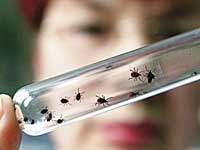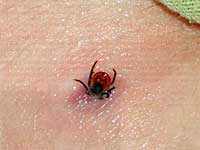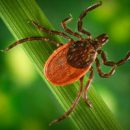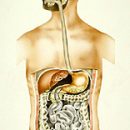Science is known over 10 thousand species of ticks. In the process of evolution, one of them began to conduct a free lifestyle, others parasitize on plants and animals. Pliers are causative agents and carriers of many human diseases. About them - in our article.
Content
Pincers — Invertebrate animals belonging to the class of spider-shaped. All over 10 thousand species of ticks, characterized by externally and leading various lifestyle. In the process of evolution, one pincers elected aquatic element as a habitat, others began to parasitize on plants and animals.
General characteristics of ticks
 Despite some differences, ticks have common external signs. The body of an adult individual has a rounded or oval shape and dimensions from 0.2 mm to 3 cm. Four pairs of limbs equipped with tenacious «hooks», allow the mesmer to be pretty quickly moving even on the sheer surface. At the head end of the tick there is a more or less movable head and a trunk forming a suction machine. Most ticks breathe tracheans, although some of the class representatives are completely devoid of breathing apparatus.
Despite some differences, ticks have common external signs. The body of an adult individual has a rounded or oval shape and dimensions from 0.2 mm to 3 cm. Four pairs of limbs equipped with tenacious «hooks», allow the mesmer to be pretty quickly moving even on the sheer surface. At the head end of the tick there is a more or less movable head and a trunk forming a suction machine. Most ticks breathe tracheans, although some of the class representatives are completely devoid of breathing apparatus.
As representatives of an ancient class, ticks are adapted to various habitats. Some of them live in the soil, in the MSh, the forest litter, others lead a free lifestyle and feed on small animals, the third parasitic lifestyle leads, are attached to the owner's body and feed on its juices or particles of the cover.
Practical value of man ticks
As parasites of humans, pets and plants, ticks play a negative role, because they are pests of food reserves, carriers and pathogens of many diseases.
Of the mancoptes scabiei sarcoptes sarcoptes sarcoptes scabiei, which lives in a corporate skin layer and causing such a disease, like scabies, zezhnice acne or demodex Demodex Folliculorum, settling in coarse glands, causing them inflammation and development of demodecosis. Ticks can not only hit human skin, but also organs of the gastrointestinal tract, eyes, ears.
Pliers, which are not human parasites, however, can cause allergies. In contact with the products of their livelihoods in hypersensitive people, the development of allergic rhinitis, conjunctivitis, bronchial asthma is possible. Food infected with ticks often causes food poisoning and gastrointestinal disorders. In 1972, Mulvey tied the development of sudden child death syndrome with an allergic reaction to ticks.
Much attracts ticks that are able to endure infections of infections in their body and to transfer them to a person when bite.
Acariase — man's disease caused by ticks
Human disease caused by ticks is called acariasis.
Among them, tick dermatitis, deep acariases, mite allergies.
The disease caused by ticks includes:
- Akorodermatites;
- pulmonary acariasis;
- arganidosis;
- ambimose;
- Argasosis;
- Blomise;
- Gamazoidosis;
- demodecosis;
- dermatophagoid;
- dermatisosis;
- dermatorosis;
- Euroglifoz;
- scabies grain;
- Snake ticky dermatitis;
- Ixodiosis;
- intestinal acariasis;
- ticky sensitization;
- paralysis of the tick
- rat tick dermatitis;
- mouse tick dermatitis;
- Laminosiotosis;
- notooderosis;
- ophthalmocariasis;
- detectation;
- tickful food anaphylaxis;
- pseudosarkoptosis;
- Ripicephalis;
- hay itching;
- Tiroglyphosis;
- Tarson Ministry;
- Urinar acariasis;
- a acariasis;
- Hayleteyllese;
- Hayletoz;
- Histingogastrosis;
- scabies;
- Epidermoptosis and other diseases.
Blood axes — Minders of human diseases
 Diseases transmitted by man when tick bite are called transmissible diseases. Pliers in this case are a kind of tank of causative agents of infection, retain it throughout their life and are often transmitted from generation to generation, laying infected eggs, of which infected larvae appear on the light.
Diseases transmitted by man when tick bite are called transmissible diseases. Pliers in this case are a kind of tank of causative agents of infection, retain it throughout their life and are often transmitted from generation to generation, laying infected eggs, of which infected larvae appear on the light.
In Russia, annually at the reception to doctors due to bites, hundreds of patients are treated, and this is not wonderful, because Russia is the largest habitat of ticks. Infection pathogens fall into the human body at the time of the tick bite, together with his «saliva» and the contents of the intestine.
All transmissive diseases are inherent natural foci, seasonality of outbreaks, associated with periods of ticks, acute start of infection, symptoms of intoxication, damage to the nervous system and the presence of spindles on the skin.
Transmissible diseases
- Tick-borne encephalitis — The most common and severe encephalitis from all epidemic diseases.
- Cleaning borreliosis or Lyme disease bringing chronic recurrent flow.
- Radiant ticky tyif.
- Return mite typhus.
- Marseille fever.
- Hemorrhagic fever.
- Spotted Freshland Rocky Mountains.
- Fever Tsutsugamushi.
- Tularemia.
- Erlichiosis.
- Babezia.
- North Asian ticks ricketersiosis.
- Vesiculse Rickeciosis and other infections.









